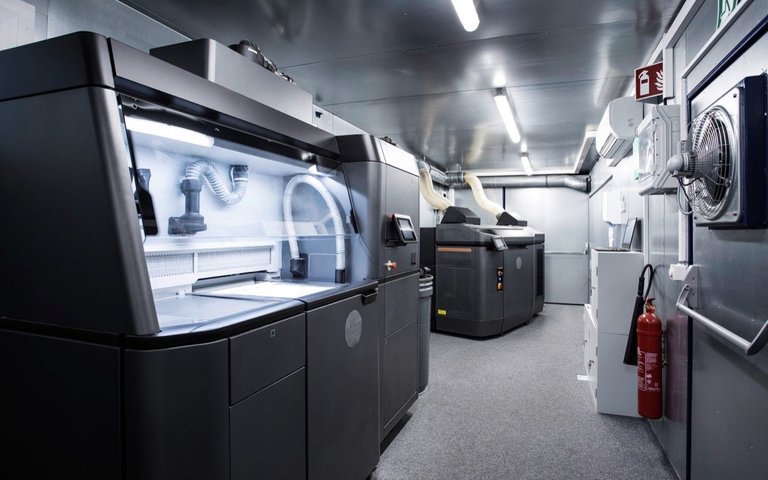3-D Printing And Spare Parts
For those who take a courtesy look at technology, it is easy to see how some things are touted as being promising yet miss what is taking place to truly revolutionize things. This is because a lot of the nitty gritty is not written on the mainstream investing or business sites. Instead, they cover the top-level stuff while omitting many of the finer details.
This is fine since that is the audience that is being targeted. It is, however, why many are caught off guard when things seemingly explode.
One such area is 3-D printing. By now, most have heard of this. Personally, I wrote a number of articles about this technology, especially as it pertains to housing. That is far from the only area we are going to see an impact.
While the contour manufacturing market is just getting started, we are seeing another area that is really beginning to take shape. It is further along than what was just mentioned and already starting to have an impact.
It is expected that one of 3-D printing's greatest contributions is in the area of parts. This is somethin that drives businesses crazy. Who has not worked for a company where a machine was down because "they were waiting on a part". This affects offices with the copy machine and manufacturing with far more advanced equipment.
Those days might end up being gone in a few years. 3-D printers are starting to step in as a solution to this problem.
Hewlett Packard is one of the companies that is making headway in this market. They are quickly becoming one of the leading 3-D printing companies. Recently, Daimler started to leverage the HP technology to set up mobile printing facilities to handle the parts creation for the buses they manufacture.

Wait time on parts is something that Dailer is looking to eliminate. Setting up pilot projects in Germany, the hope is they can be closer to their customers, thus getting parts there quickly. Plus, the printers can print what is needed immediately, from the growing catalog of parts.
Using 3D printing Daimler Buses can react fast and flexibly to urgent customer requirements, for example when customers order rarely required parts or have special requests. Instead of a wait of several weeks as for conventional spare parts, production and delivery of a 3D printed part take only a few days. Just under 40,000 bus spare parts are already 3D printable today.
This cuts to the core of the 3-D printing debate. While it is still slower than conventional manufacturing processes, the later occurs when running at max production. When, however, individual parts are needed, then things can get very hairy if it is a part not utilized frequently.
3-D printing offers the ideal solution.

What we are seeing is all a part of decentralization. We often discuss this concept within cryptocurrency but technology is allowing this to take place everywhere. As the pictures above show, a cargo bin can be easily reconfigured to be a mobile print shop, generating parts locally as opposed to some central location.
It is a concept that is going to have major implications upon supply chains. One of the worst things that any company has to deal with is the attempt at stocking of parts. Whether it is the end user or the servicing entity, it is impossible to always have the right mix. Nobody knows when a particular part is going to be down. This extends all the way up to manufacturers who often are caught blind, missing a particular part on a global basis. This is why part delays can take weeks.
That is a lot of lost production, something that customers are not happy about.
Yet, this concept is only a step in the process. There is another step that is intended to take the decentralization further.
In the next step, Daimler Buses intends to further expand and decentralize the business model: customers will then be able to purchase 3D printing licenses from the “commerce” section of the Omniplus On portal and have the corresponding parts produced in a 3D printing center certified by Daimler Buses. As printing centers of this kind are still uncommon, these mobile mini-factories represent an expansion of the planned business model.
The next step will be to have Daimler's customers set up their own mobile mini-factories complete with the 3-D printers and, through licensing, have them create the parts themselves.
Ultimately, this is a major paradigm shift. What 3-D printing is doing is changing the entire mode of distribution.
Instead of having a manufacture then distribute model, we are heading towards distribute, then manufacture.
Since it is quicker, easier, and less expensive to send a digital file, that will be distributed electronically with the physical item manufactured locally.
It is fairly obvious this impact this could have and how many different industries (and countries) this could affect.
Images from article linked
If you found this article informative, please give an upvote and rehive.

gif by @doze

logo by @st8z
Posted Using LeoFinance Beta
It's a great idea and one that will be needed in the future and like you mentioned with bus spare parts. I always buy 2nd hand cars and often go to car yards for 2nd hand parts. Cheaper and I prefer older sports cars. I'm a Holden man (GM)
But now that Holden has left the nation it will be harder to get parts in the future. A great business idea would be to establish a car parts shop solely with a 3D printer specialising in older models.
None of this waiting for imported items etcs. Make an order, click and collect in a few days when it's ready.
Posted Using LeoFinance Beta
There was a firm that was about 45 minutes from me that became renowned for fabricating old parts for Corvettes. They were around forever, well known. However, GM started to 3-D print the parts from digital files and put them out of business.
It is amazing how quickly a technology can disrupt a business. Decades of success gone in a couple years.
Posted Using LeoFinance Beta
Oh wow GM did it more affordable than a firm. In Australia it's the other way around. But we lost GM (Holden) thats why my V6 SV6 Sports Wagon is gonna be a relic in the future 🤣 but I need a 3d printer parts will be hard to come by.
Posted Using LeoFinance Beta
This is an interesting idea. So rather than people buying their own 3D printers and building their own parts, we will be leasing out a printer and have it print items?
Posted Using LeoFinance Beta
Instead of Daimler doing it, the end user will pay for the digital file through a licensing fee and print it out themselves. Most of those printers go for well over $100K, so I imagine they are all financed.
Posted Using LeoFinance Beta
3D printing has a bright future for sure, I was listening to an interesting Discord chat about 3D printing and guns. Now that really shifts the balance of power away from the State.
The only problem I've got is that I can't really use one with a small off grid power system, although there's no reason I couldn't upgrade, they do feel like an integral part of the decentralised future.
And unlike bitcoin I can't imagine anyone's going to Fud them based on their intense use of plastic, that can't be too good for the environment - I think like most other areas of business, the market will overlook this.
Posted Using LeoFinance Beta
Guns certainly got on the radar and the technology is still a bit to go. Right now it all very big machines that require a lot of money and power. It will get better in time.
You are right, this is a big step away from the centralization process.
Posted Using LeoFinance Beta
I imagine this even at a retail scale in the future. Receive the raw materials for the 3D printer and instructions on a stick for the printer. Then go to a local 3D printing center and print the ordered component according to received instructions.
Posted Using LeoFinance Beta
Eventually it will be in everyone's homes. We will see that people have these and just buy the raw materials. That is probably a decade or more away.
Posted Using LeoFinance Beta
It depends on the scale of the object that needs to be printed. Regular people won't have large 3D printers in their homes. But some of these large objects may be broken down into smaller pieces like legos, for retail use.
Posted Using LeoFinance Beta
When it comes to cars I wouldn't feel super comfortable with 3D printed parts by a random 3D printer shop, unless they would offer the same guarantees as the manufacturer
Posted Using LeoFinance Beta
People buy parts that are fabricated by random shops for used cars all the time.
Actually this is safer since the digital file is going to be licensed by the manufacturer. And these printers are still well over $100K so it isnt just like some Joe opening up a shop.
Posted Using LeoFinance Beta
Anything digital can be pirated :P
Posted Using LeoFinance Beta
It's a great concept that one should needed in the future. It's a great business idea specially developing the 3D printing in old car and other technologies. So quickly 3D printing becoming business. Lisence deviations also made in 3D printing technology all things done digitally . In short our future will be bright through 3D printing. Thanks for sharing such an awesome infomated content.
Posted Using LeoFinance Beta